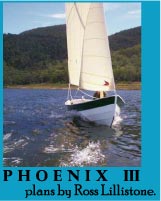| As I was browsing John Gardner's book, I saw one little boat that I really liked, the 10' Lawton tender. Then I went on searching the internet, but found only a very few examples of this boat built. I wanted to try out the old classical lines of this boat, but again, I like skin-on-frame boats, so it had to be built light.
Since I was going to build it really light I was thinking about making even the ribs out of pine/fir. Well, the only pine I can find around, is the local lumber yard with construction 2x4s. Well, I never thought of making a 2x4 pretty, but perhaps this would be the perfect opportunity. Since pine doesn't steam bend well, nor does it bend wither, I thought perhaps I will have to laminate the ribs and the keel. I knew that this is going to be a chore, so the only option I have left is to start experimenting with as many thin wood strips as I can.
After a few initial broken pieces, I finally figured out the right recipe for the ribs. I ripped the 2x4s to 5/16 pieces, then I took a long downspout that was still around my garage from the last rain gutter job, and taped shut one of the ends, all water tight with duct tape. Then I raised the open end on a horse, and filled the down spout with water and soaked my pine strips in there for about 20 minutes. Of course, the wood does not want to stay under water and wants to shoot out, but capping the downspout with a rag stuffed hard in there will hold them down. I realized that I needed about 5 pieces laminated together to give me a sturdy rib, so I soaked all 5 pieces together and then I bent them all together to shape into their final form.
 |
 |
 |
 |
 |
 |
 |
 |
 |
 |
 |
 |
Of course, prior to this exercise, I drew the stations up on a plywood. The offset numbers were really taken from a wooden boat that is much heavier than a skin-on-frame boat would be. I had to compensate for the less weight but lowering the dead rise, and also lowering the sheer line about 2' to 3" to preserve the shape and character of the boat. I drive 6" screws into the plywood along the station lines to be able to clamp the laminated pieces all at once into shape. Once I was satisfied with the shapes, I put Gorilla glue in between the laminates and put a little wax-paper liner under them so they would not stick to the plywood. After drying, in a few hours the stations, now ribs, all came out just fine. One thought though is that Gorilla glue is not really the best for laminating, next time I will use Titebond III, which is a lot stronger glue for this application. In any case, some delamination isn't that dangerous, because at each stringer I drilled a tiny whole in the rib and pushed a piece of bamboo skewer in there. Of course, the boat is skin-on-frame so I lashed the entire boat together, so the pegging in combination with the lashing made this boat rock solid.
The skin is Dacron, the thickest I could get from aircraft builder supply store, which I glued with double face tape to the gunwales, just like Platt Monfort suggests with his airolite boats. Then I sealed the dacron skin with two coats of resin. Finally, while the skin was still wet, I placed the skeg and partial keel which is about 4 feet long and 5" deep on the bottom, around the middle section of the boat on and some bottom bilge rub strips made from red oak. So as the boat lays on the ground all the contact surfaces are wood - protecting the skin. The "oar locks" are made out of laminated red oak then carved to shape as a cradle for the oars. The solution is simple and effective.
I have to say, that these are the most pretty 2x4s I have ever seen, not to mentioned how practical they are. After the sea trials, I have to say that it was a very good idea to drop the dead rise, because the boat sits on the water very nicely and is docile. However for the slightest breeze it easily ghosts along. For a sail I sewed up a three panel, broad seamed, boomless balanced lug, although I realized that it is even more practical to use it as a standing lug. The size of the mast is a bit too short only 10', so I am going to replace that with an 11' or a 12' sail, just to raise the foot of the sail a bit, but otherwise it sails very well with that 45 sq ft sail. I sailed this boat about three times, and enjoyed every moment of it, but I soon gave it away to my oldest son, who just loves it. Once in a while we go and sail together on nearby lakes and Lake Erie, I, with my transparent boat and him with his new Lawton tender. Over all, I think the boat has awesome lines and performs really well.
|













